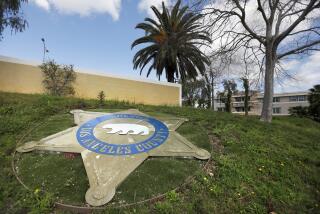Shedding the gang label
- Share via
In recent weeks, Los Angeles city prosecutors took a significant step forward in the quest to free the city and its people from the grip of gangs. But this step involves no arrests and no crackdowns. Quite the opposite -- it allows individuals now labeled as gang members but who are no longer involved in gang life (or who perhaps never were) to be removed from widespread gang injunction enforcement.
Those injunctions, pioneered by Los Angeles two decades ago, prohibit suspected members of gangs from congregating, wearing certain clothes, sporting particular tattoos or loitering. Sanctions can include six months in jail for activity that otherwise would be legal. They are among the chief tools that police and prosecutors use to suppress gang activity.
Injunctions have been effective. But they are harsh, especially on those who have worked to get beyond gang life but find themselves pulled back in, at least in the eyes of law enforcement. Officially subject to restrictions on whom they see, where they go and what they wear, former gang members can find it harder simply to attend class or get a job. Encounters with police are more likely to go poorly.
It has never been possible to get off the city’s virtual “list” of enjoined gang members. Until now. Prosecutors in City Atty. Rocky Delgadillo’s office worked through a years-long, painstaking effort with the City Council, the Police Department and community advocates to create an exit option. It took too long -- but the important point is that those branded by the city as gang members now have not just a path but an invitation to let their ties to criminal enterprises lapse.
It’s early yet. Only one person has been removed from the “list”; 15 have applied. The city attorney’s office wants more, and on Monday presented the program at a meeting of the Watts Gang Task Force. It will make a similar presentation next month in the San Fernando Valley.
Years of mistrust are not wiped away overnight, and neighborhood advocates are understandably wary of police and prosecutors who still support gang injunctions. But it is time to end the stalemate. With work and a little luck, the process for removal from gang injunction enforcement will turn out to be at least as much a violence-fighting tool as the injunctions themselves, because it lights the way out of gang life. It lets those who leave gangs without committing crimes, or after serving their time, know that they can be safe, that they can be productive and that Los Angeles wants them back.
More to Read
Sign up for Essential California
The most important California stories and recommendations in your inbox every morning.
You may occasionally receive promotional content from the Los Angeles Times.













